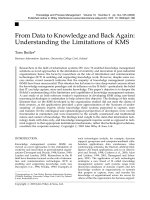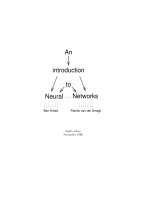Tài liệu FROM DESIGN TO DEPLOYMENT: A PRACTICAL GUIDE TO FTTX INFRASTRUCTURE ppt
Bạn đang xem bản rút gọn của tài liệu. Xem và tải ngay bản đầy đủ của tài liệu tại đây (2.44 MB, 164 trang )
THE BOOK ON
FEEDER DISTRIBUTION
DROP
Edited by Steve Grady
Forward by Sharon Stober,
Editorial Director of Outside Plant Magazine
F
ROM
D
ESIGN TO
D
EPLOYMENT
:
A P
RACTICAL
G
UIDE TO
FTTX I
NFRASTRUCTURE
www.adc.com
www.adc.com
ADC Telecommunications, Inc., P.O. Box 1101, Minneapolis, Minnesota USA 55440-1101
Specifications published here are current as of the date of publication of this document.
Because we are continuously improving our products, ADC reserves the right to change spec-
ifications without prior notice. At any time, you may verify product specifications by contact-
ing our headquarters office in Minneapolis. ADC Telecommunications, Inc. views its patent
portfolio as an important corporate asset and vigorously enforces its patents. Products or fea-
tures contained herein may be covered by one or more U.S. or foreign patents.
101081 10/05 Original © 2005 ADC Telecommunications, Inc. All Rights Reserved
THE BOOK ON
F
ROM
D
ESIGN TO
D
EPLOYMENT
:
A P
RACTICAL
G
UIDE TO
FTTX I
NFRASTRUCTURE
Edited by Steve Grady
Forward by Sharon Stober,
Editorial Director of Outside Plant Magazine
4
www.adc.com
Forward - How Do We Get There From Here?
5
FTTX: A Practical Guide
www.adc.com
Forward
How Do We Get There From Here?
By Sharon Stober, Editorial Director of Outside Plant Magazine
Convergence is a word many of us in the industry grow weary of hearing.
It oozed from the mouths of marketers during the dot-com explosion and
even during its violent implosion. Now, as our market moves from survival
to recovery mode, the word has begun to take on a life of its own once
again. It seems that convergence is as popular in the telecom world as
other over-used catch phrases such as Next-Generation Networks (NGN),
Quality of Service (QoS), and Scalable Networks.
Those who throw the term about loosely seem to ignore the reality of such
a potent theory. Although convergence is the nirvana of a single network
handling voice, data, video, and other data applications in a seamless
manner, it is by no means a simple and straight-forward evolution process.
As one industry observer said recently, "It is the Gordion Knot. You cannot
unravel one knot without creating another as a result."
1
Quite frankly, I enjoy watching convergence collide with today’s infra-
structure. To understand the vast implications surrounding that collision,
we must first examine the market conditions leading to a renewed
interest in making convergence a cost-efficient reality. And that’s where
my passion lies.
6
www.adc.com
Market Conditions
A market ripe with change brings both challenges and opportunities
to service providers aiming to thrive. Incumbent providers are losing
about 9% a year in voice traffic, which currently provides the majori-
ty of their overall revenues. (McKinsey Study). At the same time, pric-
ing structures are declining by nearly 10% a year, according to the
Gartner Group.
What’s more, service providers today are dealing with losses exceeding
$1.5 million each year for every 1000 customers they lose due to inade-
quate technology. (Gartner Group). Indeed, the pressure is mounting.
The good news? Over the next four years, broadband subscriptions are
expected to grow by 16%. (IDS Worldwide Broadband Access Services,
2004-2008). And by 2008, the video market is forecasted to climb from
$54 billion to nearly $63 billion. Now, more than ever, the infrastructure
will help determine which providers will capture the lion’s share of these
growing markets.
The potential is great for those providers willing to invest in fiber tech-
nologies while harvesting the assets of their legacy plant. The old phi-
losophy of "If we build it, they will come" no longer applies. Smart
Incumbents know they must walk a fine line, deciding when to invest
in fiber and when to upgrade the legacy plant. They are intent on tac-
tically squeezing each and every megabit out of their current infra-
structure and building future-proof networks when it makes sound
financial sense.
We see Verizon and SBC walking that fine line as they race to capture a
piece of the digital home networking market. The Wall Street Journal
reported that Verizon was the first RBOC to launch TV services in one Texas
city, and will introduce the service in other Texas communities as well. On
the heels of that first launch, Verizon will roll-out TV offerings in Fairfax
Forward - How Do We Get There From Here?
7
FTTX: A Practical Guide
www.adc.com
County, Virginia, a fast-growing suburb of Washington, D.C.; along with
a New York City suburb Massapequa Park, New York.; and a community
outside of Tampa, Florida.
SBC, which initially said it will roll out TV in late 2005, has pushed its
launch date back, possibly to early 2006. Their updated launch reflects
the company’s aim to provide TV service to 18 million homes by the first
half of 2008, nearly half of those reached by the company's networks.
Their objective: to dominate the home entertainment market with a sin-
gle package of TV, high-speed Internet, and landline services. And if tele-
com analysts are correct, close to 40% of U.S. households may have the
opportunity to get TV service from their telephone companies by 2010.
(Sanford C. Bernstein & Co). That would translate into a huge opportu-
nity for consumers and survival assurance for Incumbents. Indeed, the
future lies in holding end-users' attention. Forrester Research says that
telcos can do this by offering three things:
• Personal Entertainment
• Intelligent Devices
• Core Services
Why Fiber?
We have entered a time where the amount of bandwidth users want for
Internet services is nearly insatiable. Even just five years ago, a dial-up
modem delivering close to 56 kbps was an acceptable connection.
Today end-users find acceptability in the range of 1 Mbps and 3 Mbps.
That’s nearly 35 times the bandwidth that was acceptable in 2000.
Now, jump ahead 10 years; if this growth continues, a subscriber will
demand between 35 and 70 Mbps by 2010.
Clearly, subscriber appetites are driven by evolution and advancement of
broadband applications. Internet-savvy users are now active participants
8
www.adc.com
in the on-line experience. They transfer high-resolution digital photos,
serve content to friends, participate in interactive, graphics-intensive
gaming, and often have more than one PC connected to their home net-
works. Soon, users will demand higher upload speeds, similar to that
which they experience on downloads.
And we haven’t even begun to consider future applications! Today’s
service providers face hungry end-users and cable and/or satellite com-
petitors who intend to satiate them. Telcos have the choice to engage in
the feeding frenzy or, quite simply, be eaten.
What are the options for delivering that bandwidth? As we said before,
convergence (with its real definition, thank you) is the coming together
of disparate networks. Today, as the industry propels itself toward a sin-
gle, unified network, the very harsh reality is that service providers are still
dealing with the realities of a mixed grouping of network architectures.
These three varied architectures make for a very interesting OSP:
1. The legacy plant utilizing ADSL2/2+ and/or VDSL to deliver up to
12 megabits.
2. The SBC model of FTTN where fiber is brought to about 3,000 feet
but copper capabilities are relied on to the customer premises.
3. The Verizon, FTTP model as an optimal choice for new builds and
MDUs. For those applications, the cost of FTTP is similar to copper.
Converging these networks is both the promise and the problem for
providers today.
Today, as the telecom market has moved from survival to revival mode,
worldwide sales of telecom services are expected to rise by 6% to 7%
this year and next, according to Gartner Inc.
2
Much of that momentum
Forward - How Do We Get There From Here?
9
FTTX: A Practical Guide
www.adc.com
is attributable to growth in fiber optics. And while we’ll never see the
frenzied pace that the dot-com bubble offered before it burst, we will
likely see convergence occur as providers meld these once disparate net-
works (fiber and copper).
Drivers for this migration toward fiber include: an aging copper plant,
anticipated high take rates on bandwidth intensive applications and the
potential for customer retention when Incumbents offer bundled services.
Quite clearly, service providers looking for long-term success in this com-
petitive marketplace must find cost-efficient architectures that employ
FTTX solutions.
It’s All in the How
That’s why ADC's “The Book on FTTX” is so helpful. When making cost-
sensitive decisions about deploying FTTX, service providers must look at
today’s initial installation costs, and also peer into the future regarding
operational and maintenance expenses following service turn-up. (I wish
I had written that sentence instead of borrowing it from chapter 2!)
It’s so easy to miss that important distinction as we scurry about the
"How do we get there from here?" decision-making process. Often we
don’t take the time or we decide it’s unimportant to see both the forest
and the trees (F&T - my own acronym). All the while, we wonder why
we can’t find the right strategic and tactical solutions to the problems
confronting our organization.
This F&T theory rings true with our provider partners in SBC, BellSouth,
and Qwest as well. Each time I tell them the necessity of educating
ALL their team members – from executive level all the way into the
field – I use the F&T metaphor. They listen and soon their heads nod in
agreement, eyebrows raise and glances are exchanged across the con-
10
www.adc.com
ference room table. We all suddenly experience that Ah-ha! moment.
They get it.
To succeed, service providers must take action and educate their teams
about both the forest of FTTX as well as its trees. Without a vision from
above and clear sight of the details below, how can cost-sensitive, smart
deployment decisions be made?
That’s why I find myself drawn to Chapter 2 about Seven Killer Bs
that can help create a solid business plan by using a sound decision-
making process.
The Seven Killer Bs are:
1. Baseline
2. Bundled Services
3. Broadband Technology Options
4. Bandwidth Boundaries
5. Business Case
6. Budget
7. Build
I’ve included a great paragraph from Chapter 2 so you can see how this
device supports my argument that providers must always use a forest-
and-trees analysis as they look toward the future:
From Baseline to Business Case to Build, the ratio of CAPEX vs. OPEX
must be evaluated. In other words, carriers must decide on whether
to invest more in equipment and technology or operations and
maintenance. The decisions made to save CAPEX could result in
additional OPEX down the road – and what is the downside if the
network fails to achieve its operational goals?
--- “The Book on FTTX”, Chapter 2
Forward - How Do We Get There From Here?
11
FTTX: A Practical Guide
www.adc.com
ADC’s rather clever Killer B pneumonic device is substantive, not fluff. It
can be memorized by each member in your organization and, even bet-
ter, applied to the analysis you’re doing as you evolve the network.
Doesn’t it make sense for a C&E department to evaluate a problem on
a similar set of criteria (the forest) and have everyone speak the same
language (the trees)? "B" honest – you know it does.
Another forest we tend to ignore is the unpredictability of Mother
Nature. With the deadly wrath of hurricanes along the gulf coast, we
have to respect their sheer force. Less obvious, however, is the impact
more normal weather exerts on FTTX architectures. That’s why planning
for the worst case is critical.
Temperature, particularly cold temperatures and wide temperature vari-
ations, are directly related to insertion loss failures due to cable and cable
assembly component shrinkage. This is something manufacturers like
ADC address before equipment goes in the field. Read more about this
in Chapter 9, Challenges of Cold Temperatures on OSP Cable
Assemblies, to remind yourself that planning for the worst Mother
Nature can deliver will allow your FTTX architecture to be resilient in even
the worst weather.
Then, there are the issues that stretch beyond the OSP. Not too long
ago, all the intelligence of the network resided in the Central Office
(CO). And while a fair portion of it has moved to the networks’ edge,
the implications for the CO must be considered in the equation as well.
We know all too well that one change made to the network impacts
another. You can remind yourself of its complexity and how it dove-
tails with the OSP by reviewing Chapter 4, Central Office Implications
for Deploying FTTP.
12
www.adc.com
Another major consideration is building the link between customer and
the CO – that is, the fiber distribution portion of the network. Much
debate continues around the issue of splitter configurations. Should
providers use a centralized or cascaded approach? I’d recommend reading
Chapter 3 on this topic to help determine which side of the argument
you plan to take.
Once providers make the determination about their FTTX architec-
ture, they must consider the unknown: In new build situations, how
will the fiber be protected from the end-user? Consumers have no
problem digging up their backyard for that D.I.Y project they intend
to complete this weekend. They don’t follow the one-call rules. They
dig. Therefore, providers must decide upfront HOW they plan to treat
drop cables in Greenfield applications. Unexpected cuts and trou-
bleshooting can translate into big dollars. So, spend a bit of time
with Chapter 10, Above vs. Below Ground Drop Splicing, comparing
these two tactics in splicing. It could be that this portion of the deci-
sion-making process will make or break your OPEX budgets in the
near future.
As a final note, being an editor, I always check out the glossary of any
well-written book. It allows me to quiz myself and my team on the useful
and un-useful acronyms in our industry. (Nothing worse than hearing one
of my new staff members pronouncing "CLEC" as "C-LEG" in a phone
conversation with one of our provider partners. Just what is a C-Leg?)
Here's your assignment: Spend some refresher time with the glossary,
and send me an email sharing the page number where the authors
inserted my education-oriented acronym F&T. Remember, it’s the forest-
and-trees philosophy of learning. Then, make F&T part of your own
vocabulary and vision. Go ahead, try it at home. Most important, teach
the F&T philosophy to your team members.
Forward - How Do We Get There From Here?
13
FTTX: A Practical Guide
www.adc.com
Given the convergence of the copper and fiber networks, we’d better be
darned sure to learn a little about the F&T of FTTX. This book by ADC
is a great tool to do just that.
1
Midas, a king of Gordion, dedicated his chariot to Zeus with the yoke tied to a pole in a
very intricate knot, and declared that whoever could untie this knot would become the
king of all Asia. Many people came to untie the Gordion Knot without success.
According to legend, when Alexander the Great came to Gordion he looked at the prob-
lem from a different perspective and resolved it quickly by cutting through the knot with
his sword, thereby revealing the ends of the cord that were hidden in the middle of the
knot. Now, "cutting the Gordion Knot" has come to mean victory over a difficult busi-
ness problem.
2
See "Telecom Comes Calling," Barron's Online, Weekday Trader, July 12, 2005,
Sharon Stober is vice president, editorial director of OSP. She oversees all editorial
processes and staff for OSP Magazine, the OSP enewsletter, www.ospmag.com, and leads
the educational content development for the OSP EXPO and several roundtable events.
Stober has covered the telecom industry since 1996, when she joined OUTSIDE PLANT
magazine as editor. Prior to that she worked in advertising with Ogilvy & Mather and
CME. Stober has a bachelor’s degree in journalism/advertising from the University of Iowa
and a Masters from the University of Minnesota.
She can be reached via email:
14
www.adc.com
Editor’s Acknowledgements
15
FTTX: A Practical Guide
www.adc.com
Editor’s Acknowledgements
An undertaking such as this book can only be accomplished with the help of
many people. The first person to thank is Keri Kotz Becker who did an out-
standing job of coordinating the many content contributions and developing
the flow of this book.
As you progress through each chapter, you will find a wealth of technical know-
how, practical advice and real world experience. The following contributors have
freely shared their hard-won lessons: Tom Kampf, Trevor Smith, Pat Thompson,
Hutch Coburn, Randy Reagan, Gary Bishop, Diane O'Keefe, Laura Whipple,
Chuck Grothaus, Bob Pease and Pat Sims. The format of this book is clean and
very accessible. This is due to Terri Benson who did an outstanding job on the
layout and production. Many thanks to each of them.
We would like to thank Sharon Stober for her insightful Forward.
And just like an Oscar speech, there are those who I did not get a chance to thank.
Of course I will hear about this later, but thanks in advance to all of you as well.
Best of luck with your FTTX network. I hope that you will consider contacting
the ADC team to help you succeed. Please feel free to let me know how it is
going at
Best Regards,
Steve Grady
Vice President Global Marketing - ADC
16
www.adc.com
Table of Contents
17
FTTX: A Practical Guide
www.adc.com
Table of Contents
Chapter 1 FTTX: An Overview . . . . . . . . . . . . . . . . . . . . . . . . . . . . 19
Chapter 2 The Killer Bs of Successful FTTX Deployment . . . . . . . . . 27
Chapter 3 Advantage of Centralized Splitters in FTTP Networks . . . 37
Chapter 4 Central Office Implications for Deploying FTTP . . . . . . . . 45
Chapter 5 Splicing vs. Connectorization in FTTP Networking . . . . . 57
Chapter 6 Dramatic Attenuation in Fiber Access Terminals
at Low Temperatures . . . . . . . . . . . . . . . . . . . . . . . . . . . . . 67
Chapter 7 Challenges of Deploying APCs . . . . . . . . . . . . . . . . . . . . 71
Chapter 8 Enhancing Angle-Polished Connector Performance . . . . 77
Chapter 9 Challenges of Cold Temperatures on
OSP Cable Assemblies . . . . . . . . . . . . . . . . . . . . . . . . . . 85
Chapter 10 Above vs. Below Ground Drop Splicing . . . . . . . . . . . . . 91
Chapter 11 Ribbon vs. Loose Tube Fiber Connectorization . . . . . . . . 97
Chapter 12 Hardend Connectors vs. Field Splicing . . . . . . . . . . . . . 103
Chapter 13 Multiple Solutions for Connecting Multiple Dwelling Units . .109
Chapter 14 FTTN Challenges and Considerations . . . . . . . . . . . . . . 125
Glossary Glossary of Terms . . . . . . . . . . . . . . . . . . . . . . . . . . . . 135
Appendix A FTTP Audit . . . . . . . . . . . . . . . . . . . . . . . . . . . . . . . . . . 155
18
www.adc.com
Chapter 1 — FTTX: An Overview
19
FTTX: A Practical Guide
www.adc.com
Chapter 1
FTTX: An Overview
The Next Generation Network
Simply put, to meet the demands of current and future applications, it
is imperative that broadband access networks be able to provide the
necessary bandwidth.
Optical fiber provides the only true solution for existing and future
requirements. With optical fiber technologies, bandwidth demands are
satisfied, bringing the communications infrastructure more powerful
tools that can interface directly with homes, businesses, offices, com-
munity centers and government agencies. Optical fiber technology pro-
vides a higher capacity data transfer at very high speeds, enabling the
community or service provider to supply a wide range services and
applications, such as High Definition TV (HDTV), Video on Demand
(VoD) and high-speed data all while providing the basic fundamentals
of voice connectivity.
Broadband access equipment providers are able to offer technology
advances through the converged services of triple-play features using
network aggregation and subtending in combination with Passive
Optical Network (PON) technology. A PON is made up of fiber optic
cabling and passive splitters and couplers that distribute an optical sig-
nal through a branched “tree” topology to connectors that terminate
each fiber segment.
20
www.adc.com
The following is a partial list of advantages in using optical fiber systems:
• Higher Bandwidth Capacity • Resistance to Outside Interference
• Longer Reach • Lower Maintenance Costs
• Longer Life • Better Reliability
Communities and service providers are able to offer a wide range of
value-added services, above and beyond existing services, over a fiber
optic infrastructure.
FTTX Architecture
Communities and service providers have responded to the growing
demand for broadband services by either moving towards a wireless
solution, or upgrading their existing copper infrastructure with xDSL
technologies. Both of these technologies are readily available today
and represent a natural evolution to more applications and better uti-
lization of the copper plants. But this is considered to be an interme-
diate solution, due to rate limitations of wireless and the transmission
limitations of copper lines. Both technologies impose a technical trade-
off between rate and reach, affecting the number and types of servic-
es that can be offered. It is becoming more economical and strategi-
cally imperative for communities and service providers to start bringing
fiber as close to residential and small business premises sooner rather
than later.
To accomplish this, a number of optical fiber architectures can be con-
sidered, which include:
• Fiber-to-the-Premises (FTTP) • Fiber-to-the-Home (FTTH)
• Fiber-to-the-Business (FTTB) • Fiber-to-the-Curb (FTTC)
• Fiber-to-the-Node (FTTN)
These architectures can all be grouped under the category Fiber-to-
the-x (FTTX).
Chapter 1 — FTTX: An Overview
21
FTTX: A Practical Guide
www.adc.com
Fiber-To-The-Premises (FTTP), though an evolving technology, is not new.
Fiber-to-the-Home (FTTH) has been available for about 10 years, and
FTTP is viewed as the next logical step in the evolution of the access net-
work. In an FTTP architecture, an optical fiber is deployed all the way to
the customer’s premises or location; either to the residence (FTTH - Fiber
To The Home) or to a business (FTTB - Fiber To The Business). A Network
Interface Device (NID) is located at the customer premises in the form of
an Optical Network Termination (ONT), or Optical Network Unit (ONU).
The ONT/ONU terminates the optical access network providing direct
connectivity to feature-rich services.
FTTX is also discussed in the context of deployment scenarios such as
greenfield, overbuild, and rehabilitation, as well as hybrids of the three.
In the early years, the high cost of building an “all optical” network lim-
ited deployments to new build or “greenfield” areas. Just as infrastruc-
ture costs have decreased, and bandwidth needs have increased, com-
munities and service providers are now recognizing the alternative solu-
tion to “overbuild” their networks with optical fiber.
The initial investment required for optical fiber deployments is still fairly
high and may require a proven return on a particular business case. A
phase-by-phase approach is an alternative where the optical fiber access
starts with a Fiber-to-the-Node (FTTN) type of deployment. In FTTN con-
figurations, an optical link is deployed to the ONU in a Service Area
Interface (SAI) cabinet located near a residential community, subdivision
or business setting. The ONU will convert the optical signal into an elec-
trical signal where the services are easily transferred to existing copper
facilities. Due to the shorter reach of the copper infrastructure, service
providers are able to offer higher bandwidth services without having to
place the optical fiber directly to the premises. Future FTTP configuration
upgrades can be economically justified, as a natural second phase, serv-
ice requirements grow.
22
www.adc.com
Greenfield
The ultimate FTTP deployment is the greenfield scenario in newly built
areas where there is no existing broadband infrastructure and no con-
strictions exist. In new neighborhoods and planned communities, the
application of FTTP is easy to justify as initial overheads are quickly
repaid; the difference in infrastructure costs for fiber and copper is neg-
ligible, and construction costs are equivalent. Fiber greatly reduces future
maintenance costs for the physical plant, thus it makes sense to deploy
fiber to residences and businesses in greenfield applications. Greenfield
customers include:
• Single-Family Units (SFU)
• Multi-Dwelling Units (MDU)
• Small Business Units (SBU)
• Small/Medium Business Multi-Tenant Units (MTU)
Because of the nature of these new developments, a relatively high take-
rate for second phone lines, data, and video services can be assumed,
creating higher revenues and lowering the cost of deployment.
Furthermore, due to the dense populations of FTTP customers in green-
field applications, fiber can be cost-effectively run all the way from the
Central Office (CO) to the Local Convergence Point (LCP), where the first
passive split can be made.
Overbuild
The full overbuild scenario is an FTTP application. Where market demand
for advanced data and video services exists in serviced neighborhoods,
it may be desirable to deploy fiber along with the existing copper net-
work. The following factors can contribute to a decision to overbuild an
existing plant:
Chapter 1 — FTTX: An Overview
23
FTTX: A Practical Guide
www.adc.com
• Aging infrastructure
• High projected take-rates
• Competitive pressures
• Requirement for higher bandwidths than available with the
current copper technologies.
The objective of the full overbuild with fiber is to gradually transition
all customers to the FTTP system, while concurrently, retiring the
aging copper plant and the active infrastructure such as Digital Loop
Carrier (DLC).
Rehabilitation
The rehabilitation scenario aims to minimize capital expense when there
is insufficient justification. It is identical to that of the greenfield sce-
nario, and all services are provided to all customer premises. The differ-
ence is that rehabilitation involves existing customers, served with exist-
ing services over an existing copper plant. Voice and data services are
provided on the copper network, and video on an existing coaxial net-
work, if such exists. FTTP and FTTN Optical Network Units (ONUs) are
installed in close proximity to customer premises. Should there be a
need for high-speed data, it can be provided from the ONUs to request-
ing customers.
The Various Flavors of PON
The great promise of PON is the ability to relieve bottlenecks in the
access network, but there are several different PON standards to con-
sider when planning your network, as well as many different
acronyms to help confuse the issue. As PON technologies have
evolved over the past two decades, a variety of “flavors” of PON
have emerged.
24
www.adc.com
APON (Asynchronous Transfer Mode PON)
The first PON standard was APON, which uses ATM encapsulation of
transported data and is aimed primarily at small business applications.
Over time, APON was followed by BPON.
BPON (Broadband PON)
Currently the most popular form of PON being rolled out today, BPON
offers improved and additional features. It is a robust network that
includes WDM support for video overlay, higher upstream bandwidths,
and upstream bandwidth allocation.
EPON (Ethernet PON)
Ratified in 2004, EPON is the standard of the Institute of Electrical and
Electronics Engineers Inc. (IEEE) Ethernet in the First Mile (EFM). Running
at 1.25 Gbit/s symmetric, it is highly suitable for data services. EPON uses
Ethernet rather than ATM data encapsulation.
Chapter 1 — FTTX: An Overview
Class 5 Switch
Tandem
DS1
DS3
OCX
GR-303
Gateway
Network
Element
ATM
Switch
Network
Element
OCX
BRAS
Network
Element
Router
OCX
IP
DS1
DS3
OCX
GigE
APON/
BPON
ONT
OCX
BPON OLT
Network Element
Internet
Class 5 Switch
Tandem
DS1
DS3
OCX
GR-303
Gateway
Network
Element
10/100
1000BT
BRAS
Network
Element
Router
DS1
DS3
OCX
GigE
EPON
ONT
Multi
Gigabit
Interface
EPON OLT
Network Element
Internet
Layer 2 Switch w/QoS
Network Element
10/100
1000BT
10/100
1000BT
IAD
IAD
Figure 1.1
APON and BPON
Networks
Figure 1.2
EPON Network
25
FTTX: A Practical Guide
www.adc.com
GPON (Gigabit PON)
GPON is an IP-based protocol designed for IP traffic and is the standard
choice for high-volume FTTP carriers. GPON is often described as
combining the best attributes of BPON and EPON at gigabit rates. It
recognizes gigabit Ethernet interfaces to enable pure IP transport and
does not require active powering points in the access network. GPON is
the platform for all FTTP deployments, enabling the “triple play” of
voice, video and data.
What You Need to Consider
This introductory chapter provided you an overview of the various FTTX
architecture options. The next chapter explores the drivers and condi-
tions that determine which architecture you select. The choices you
make early in the planning process are make-or-break decisions that
have lasting impact, so it is critical that you assess a number of internal
and external factors before the planning even begins. A thorough,
clear-eyed analysis is the key to crafting a solid deployment strategy.
Class 5 Switch
Tandem DS1 GR303 and TR08
GPON
ONT
Multi
Gigabit
Interfaces
GPON OLT
Network Element
Integrated GR303 Voice Gateway
Internet
IAD
Tandem
Class 5
Soft Switch
SDV HE
Cisco Router
Layer 2/3 Switch
TR-57
POTS
VoIP
Protocol
Stack
Figure 1.3
GPON Network









